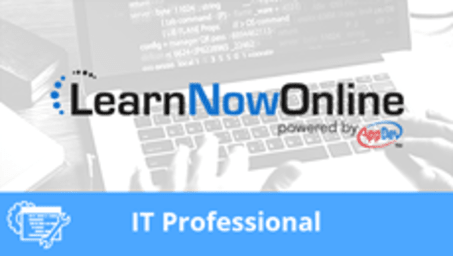
Configuring Windows Devices, Part 3 of 8: Configure Device Settings
Course description
A number of new features have been added to or enhanced with Windows 10. This course starts with an overview of configuration tools and common Configuration options. It then talks about managing user accounts, using Control Panel, and Admin tools. It finishes with how powerful using Powershell can be. This course is part of the 70-697 exam preparation.
Each LearnNowOnline training course is made up of Modules (typically an hour in length). Within each module there are Topics (typically 15-30 minutes each) and Subtopics (typically 2-5 minutes each). There is a Post Exam for each Module that must be passed with a score of 70% or higher to successfully and fully complete the course.
Prerequisites
This is part 3 in the series.
Meet the expert
Patrick Loner
Patrick Loner has certifications for MCSA, MCSE, MCITP, A+, Network+, Security+, and more. He has been working as a Microsoft Certified Trainer, network administrator, and network consultant for over ten years. He has over a decade of experience working with and teaching about Windows networks with client and server operating systems. He has guided many students toward Microsoft and CompTIA certifications. Most recently, he has worked as a freelance trainer and network consultant specializing in Windows Server 2008 and Microsoft Exchange 2007 and Exchange 2010 implementations, design, and upgrades. Patrick continues to branch out now working with and training on Windows Server 2012, Windows 8, Exchange 2013, and System Center Configuration Manager 2012.
Video Runtime
128 Minutes
Time to complete
168 Minutes
Course Outline
Configuring Windows 10
Overview of Configuration Tools (11:43)
- Introduction (00:12)
- Configure Device Settings (01:36)
- Overview of Configuration Tools (02:50)
- Demo: Management Tools (04:29)
- Demo: PowerShell (02:27)
- Summary (00:08)
Comon Configuration Options (17:45)
- Introduction (00:08)
- Finding Configuration Options (01:06)
- System Options (01:56)
- Devices Options (00:55)
- Network and Internet Options (01:06)
- Personalization Options (00:56)
- Accounts Options (01:37)
- Time and Language, Ease of Access, and Privacy (00:36)
- More Configuration Options (00:51)
- Demo: Settings App (04:20)
- Demo: Settings App Continued (04:02)
- Summary (00:08)
Managing User Accounts (20:16)
- Introduction (00:08)
- Managing User Accounts (02:53)
- Creating Accounts (01:29)
- Local Accounts (01:32)
- Demo: Local Accounts (06:07)
- Domain-Based User Accounts (02:41)
- Joining the Domain (02:18)
- Demo: Add Computer to Domain (02:57)
- Summary (00:08)
Using Control Panel (07:26)
- Introduction (00:08)
- Control Panel (02:30)
- Demo: Control Panel (04:39)
- Summary (00:08)
Admin Tools and PowerShell
Using Admin Tools (28:34)
- Introduction (00:08)
- Admin Tools (01:30)
- Microsoft Management Console (03:24)
- Demo: Administrative Tools (04:23)
- Remote Server Administrative Tools (01:07)
- Demo: RSAT (03:37)
- Remote Management (03:18)
- Graphical Utilities (03:35)
- Demo: Remote Assistance and Remote Desktop (03:18)
- Demo: Remote Connections (04:01)
- Summary (00:08)
Using PowerShell (43:13)
- Introduction (00:08)
- PowerShell (03:45)
- Cmdlet Syntax (02:59)
- Accessing with PowerShell (02:38)
- Demo: PowerShell Basics (04:58)
- Demo: Using Variables (04:57)
- Demo: Filtering and Aliases (04:27)
- Windows PowerShell ISE (02:08)
- Demo: PowerShell ISE (05:10)
- Remote Command Line Administration (01:05)
- Remoting Types (01:23)
- Native and Non-native Cmdlets (00:56)
- ComputerName Parameter (01:05)
- Demo: Remote Management (03:15)
- Demo: Invoke Commands (04:03)
- Summary (00:08)







